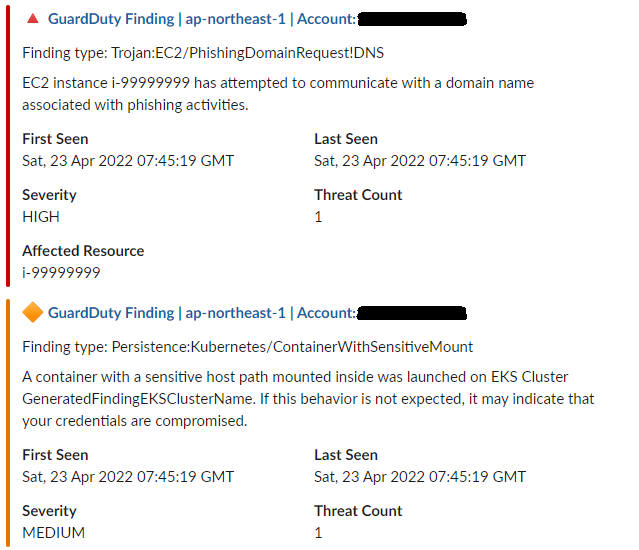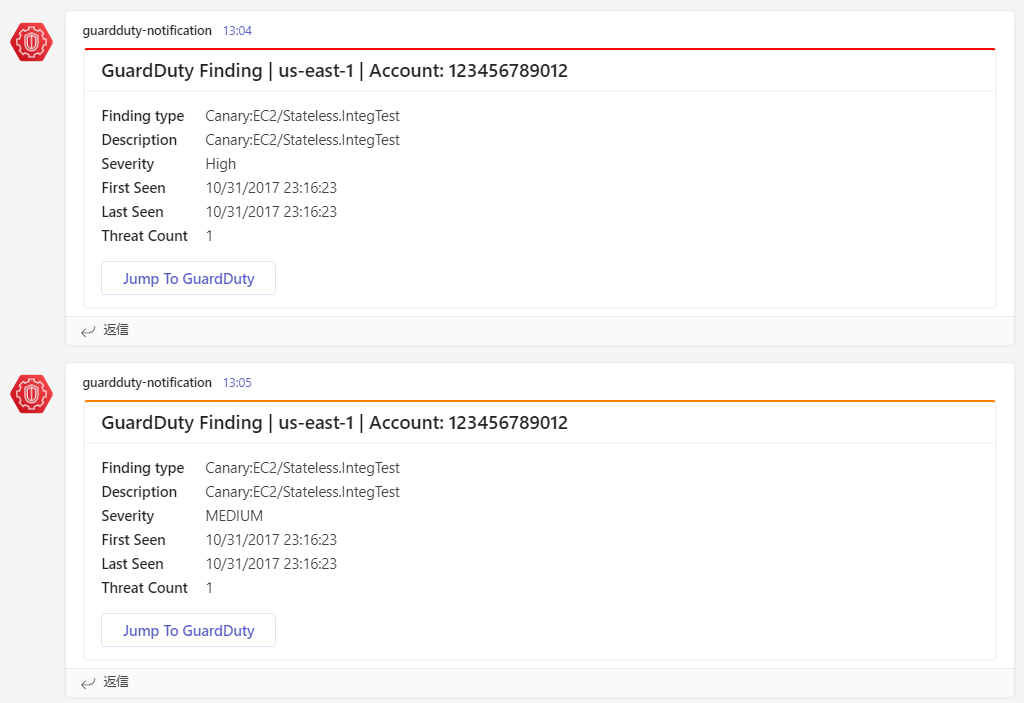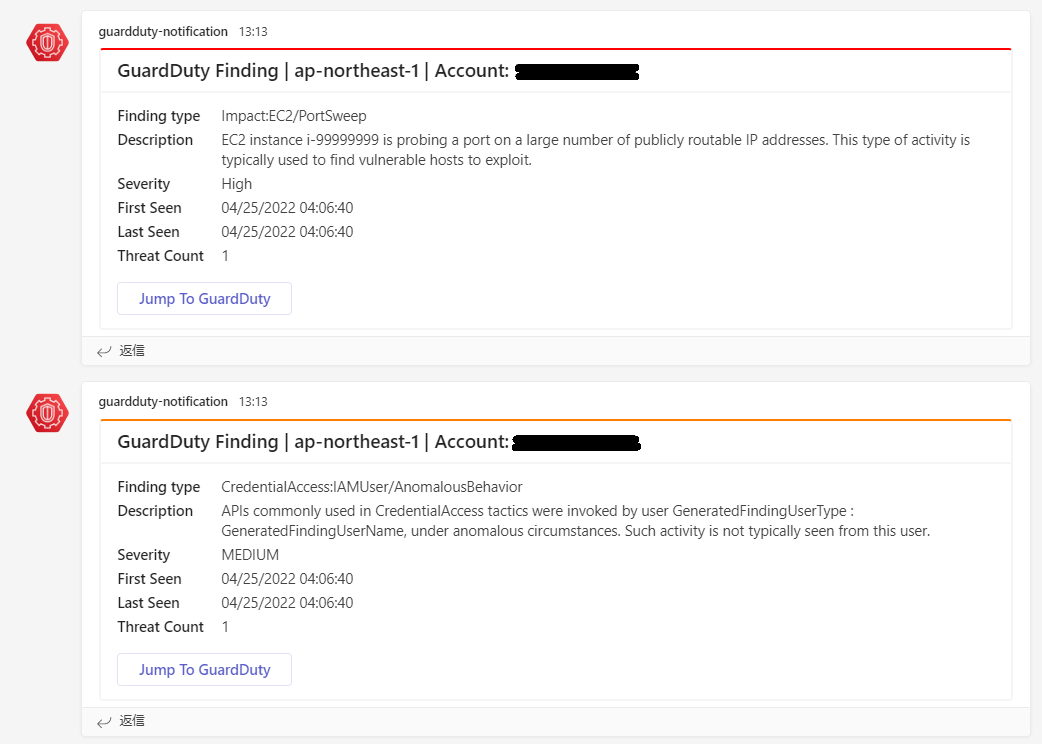初めに
生産技術部で製品の検査工程を担当しているエンジニアです。AWSのセキュリティ対応のため、GuardDutyを利用しています。GuardDutyを利用することで、悪意のあるアクティビティや異常な動作を継続的にモニタリングすることができます。しかし、検知した結果に気が付かなければ意味がありません。チャットツールに結果を転送することで、早急な対応ができる体制を目指します。
Slack/Teamsへの通知方法
脅威を検知した結果は、自動的にEventBridge(旧Amazon CloudWatch Events)に送信されるため、EventBridgeでイベントをトリガします。
- Slackを利用されている場合は、EventBridgeからSNSに転送します。SlackはChatbotとの連携が可能なため、ChatbotをSNSのターゲットにします。
- Teamsを利用されている場合は、LambdaをEventBridgeのターゲットとし、Lambdaで結果を加工してIncoming WebhookでTeamsに転送します。
Slackを利用する場合のCloudformation
GuardDutyはCloudTrail、Kubernetes、VPCフローログ、DNSログ等をもとに脅威検知を行います。ただし、これらの設定は不要であり、GuardDutyを有効にするだけで脅威検知が自動的に開始されます。EventBridgeは、以下に記載されているイベントのルールを設定し、TargetにSNSのトピックを指定します。
SNSのエンドポイントにはChatbotのAPI https://global.sns-api.chatbot.amazonaws.com を指定します。ChatBotはあらかじめAWSコンソールからSlackと連携しておきます。CloudformationのChatBotには以下を設定します。
- SnsTopicArnsにSNSトピックのARNを指定します。
- SlackChannelIdを指定します。対象のSlackチャンネルを右クリックし、「リンクをコピー」を選択します。コピーしたURLの最後のスラッシュ以降の文字列が対象のIdになります。
https://sample.slack.com/archives/XXXXXXXXXXX - SlackWorkspaceIdを指定する。ChatBotのAWSコンソールから確認できます。
これらのIdはパラメータストアに保存し、読み込んで使用しています。
AWSTemplateFormatVersion: "2010-09-09"
Description: Guard Duty
# ------------------------------------------------------------------------------
# Resources
# ------------------------------------------------------------------------------
Resources:
GuardDuty:
Type: AWS::GuardDuty::Detector
Properties:
Enable: True
FindingPublishingFrequency: FIFTEEN_MINUTES
EventRule:
Type: AWS::Events::Rule
Properties:
Description: guardduty notification
Name: guardduty-notification
EventPattern:
source:
- aws.guardduty
detail-type:
- GuardDuty Finding
State: ENABLED
Targets:
- Arn: !Ref Topic
Id: sns-topic
Topic:
Type: AWS::SNS::Topic
Subscription:
Type: AWS::SNS::Subscription
Properties:
Protocol: https
TopicArn: !Ref Topic
Endpoint: "https://global.sns-api.chatbot.amazonaws.com"
ChatBot:
Type: AWS::Chatbot::SlackChannelConfiguration
Properties:
ConfigurationName: GuardDutyNotification
GuardrailPolicies:
- "arn:aws:iam::aws:policy/ReadOnlyAccess"
IamRoleArn: !GetAtt ChatBotRole.Arn
LoggingLevel: NONE
SlackChannelId: "{{resolve:ssm:GuardDutySlackChannelId:1}}"
SlackWorkspaceId: "{{resolve:ssm:GuardDutySlackWorkspaceId:1}}"
SnsTopicArns:
- !Ref Topic
UserRoleRequired: false
ChatBotRole:
Type: AWS::IAM::Role
Properties:
AssumeRolePolicyDocument:
Version: 2012-10-17
Statement:
- Effect: Allow
Principal:
Service: chatbot.amazonaws.com
Action: sts:AssumeRole
ManagedPolicyArns:
- arn:aws:iam::aws:policy/ReadOnlyAccess
Slackへの通知の確認
ChatbotとSlack間の疎通は、ChatbotのAWSコンソールから、「テストメッセージを送信」をクリックすることで確認できます。Slackには以下のようなメッセージが送信されます。
GuardDutyからSlackまでの疎通はGuardDutyのAWSコンソールから設定の「結果サンプルの生成」をクリックすることで結果のサンプルが自動で生成され、確認することができます。Slackには以下のようなメッセージが送信されます。新しい結果は、5分以内にEventBridgeに送付されます。
Teamsを利用する場合のCloudformation
Slackへ通知する場合との違いは、EventBridgeのターゲットをLambdaに設定するところです。
AWSTemplateFormatVersion: "2010-09-09"
Description: Guard Duty
# ------------------------------------------------------------------------------
# Resources
# ------------------------------------------------------------------------------
Resources:
GuardDuty:
Type: AWS::GuardDuty::Detector
Properties:
Enable: True
FindingPublishingFrequency: FIFTEEN_MINUTES
EventRule:
Type: AWS::Events::Rule
Properties:
Description: guardduty notification
Name: guardduty-notification
EventPattern:
source:
- aws.guardduty
detail-type:
- GuardDuty Finding
State: ENABLED
Targets:
- Arn: !GetAtt Function.Arn
Id: lambda
EventPermission:
Type: AWS::Lambda::Permission
Properties:
Action: lambda:InvokeFunction
FunctionName: !Ref Function
Principal: events.amazonaws.com
SourceAccount: !Ref AWS::AccountId
SourceArn: !GetAtt EventRule.Arn
Function:
Type: AWS::Lambda::Function
Properties:
Handler: guardduty-notification
Role: !GetAtt LambdaRole.Arn
Code:
S3Bucket: "{{resolve:ssm:S3BacketLambda:1}}"
S3Key: guardduty-notification.zip
Runtime: go1.x
ReservedConcurrentExecutions: 1
Timeout: 5
TracingConfig:
Mode: Active
Environment:
Variables:
TeamsUrl: "{{resolve:ssm:TeamsUrl:1}}"
LambdaRole:
Properties:
AssumeRolePolicyDocument:
Statement:
- Action:
- sts:AssumeRole
Condition: {}
Effect: Allow
Principal:
Service: lambda.amazonaws.com
Version: 2012-10-17
ManagedPolicyArns:
- arn:aws:iam::aws:policy/service-role/AWSLambdaBasicExecutionRole
Tags:
- Key: f-iot.service.name
Value: lambda
Type: AWS::IAM::Role
Teamsを利用する場合のLambda
EventBridgeから受け取ったイベントを加工し、必要な情報を環境変数から読み込んだTeamsUrlに対して、送信します。実装の手順は、GuardDutyからEventBridgeに送付されるイベントのサンプルを参考に構造体を作成し、必要なデータを抽出します。TeamsのWebhookのデータフォーマットに加工してPOSTすれば完了です。
/// main GuardDutyが脅威検出した結果を通知します。
package main
import (
"bytes"
"context"
"encoding/json"
"fmt"
"net/http"
"os"
"strconv"
"github.com/aws/aws-lambda-go/events"
"github.com/aws/aws-lambda-go/lambda"
)
type Service struct {
EventFirstSeen string `json:"eventFirstSeen"`
EventLastSeen string `json:"eventLastSeen"`
Count int `json:"count"`
}
type GuardDutyEvent struct {
AccountId string `json:"accountId"`
Id string `json:"id"`
Type string `json:"type"`
Region string `json:"region"`
Service Service `json:"service"`
Severity float32 `json:"severity"`
Description string `json:"description"`
}
type Fact struct {
Name string `json:"name"`
Value string `json:"value"`
}
type Section struct {
Facts []Fact `json:"facts"`
}
type Target struct {
Os string `json:"os"`
Uri string `json:"uri"`
}
type Link struct {
Type string `json:"@type"`
Name string `json:"name"`
Targets []Target `json:"targets"`
}
func HandleLambdaEvent(_ context.Context, event events.CloudWatchEvent) {
var guardDutyEvent GuardDutyEvent
if err := json.Unmarshal(event.Detail, &guardDutyEvent); err != nil {
os.Exit(1)
}
TeamsUrl := os.Getenv("TeamsUrl")
var color string
var servirityCategory string
if guardDutyEvent.Severity >= 7.0 {
color = "#ff0000"
servirityCategory = "High"
} else if guardDutyEvent.Severity >= 4.0 {
color = "#fd7e00"
servirityCategory = "MEDIUM"
} else {
color = "#0000ff"
servirityCategory = "LOW"
}
facts := []Fact{
{Name: "Finding type", Value: guardDutyEvent.Type},
{Name: "Description", Value: guardDutyEvent.Description},
{Name: "Severity", Value: servirityCategory},
{Name: "First Seen", Value: guardDutyEvent.Service.EventFirstSeen},
{Name: "Last Seen", Value: guardDutyEvent.Service.EventLastSeen},
{Name: "Threat Count", Value: strconv.Itoa(guardDutyEvent.Service.Count)},
}
sections := []Section{{Facts: facts}}
guarddutyURL := "https://console.aws.amazon.com/guardduty/home?region=" + guardDutyEvent.Region + "#/findings?search=id=" + guardDutyEvent.Id
targets := []Target{{Os: "default", Uri: guarddutyURL}}
links := []Link{{Type: "OpenUri", Name: "Jump To GuardDuty", Targets: targets}}
payload, err := json.Marshal(struct {
Summary string `json:"summary"`
Type string `json:"@type"`
ThemeColor string `json:"themeColor"`
Title string `json:"title"`
Sections []Section `json:"sections"`
PotentialAction []Link `json:"potentialAction"`
}{
Summary: "Summary",
Type: "MessageCard",
ThemeColor: color,
Title: "GuardDuty Finding | " + guardDutyEvent.Region + " | Account: " + guardDutyEvent.AccountId,
Sections: sections,
PotentialAction: links,
})
if err != nil {
fmt.Println(err)
return
}
resp, err := http.Post(TeamsUrl, "application/json; charset=UTF-8", bytes.NewReader(payload))
if err != nil {
fmt.Println(err)
return
}
defer resp.Body.Close()
if resp.StatusCode != http.StatusOK {
fmt.Printf("HTTP: %v\n", resp.StatusCode)
}
}
func main() {
lambda.Start(HandleLambdaEvent)
}
Teamsへの通知の確認
LambdaとTeams間の疎通は、LambdaのAWSコンソールから、テストイベントを作成し「テスト」をクリックすることで確認できます。テストイベントのイベントJSONは、EventBridgeのAWSコンソールからサンドボックスに進み、サンプルイベントを「GuardDuty Finding」にすることで、簡単にサンプルを取得することができます。取得したサンプルをもとに、Lambdaを実行するとTeamsには以下のようなメッセージが送信されます。
GuardDutyからTeams間の疎通は、Slackの場合と同様に「結果サンプルの生成」をクリックすることで確認できます。
最後に
GuardDutyからSlack/Teamsに脅威検知結果を送信する仕組みを実装しました。ChatBotであればお手軽で、Lambdaであれば自由にカスタマイズでき、どちらも良かったと思います。GuardDutyの結果だけでなく、CodePipelineの実行結果なども同様の仕組みでチャットツールに通知することができますので、ぜひ試してみてください。




